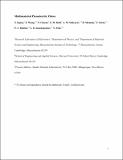Multimaterial Piezoelectric Fibres
Author(s)
Egusa, S.; Chocat, Noemie; Stolyarov, Alexander Mark; Fink, Yoel; Wang, Zheng; Ruff, Zachary; Shemuly, Dana; Sorin, Fabien; Rakich, Peter T.; Joannopoulos, John; ... Show more Show less
Downloadjoanop piezo.pdf (1.908Mb)
PUBLISHER_POLICY
Publisher Policy
Article is made available in accordance with the publisher's policy and may be subject to US copyright law. Please refer to the publisher's site for terms of use.
Terms of use
Metadata
Show full item recordAbstract
Fibre materials span a broad range of applications ranging from simple textile yarns to complex modern fibre-optic communication systems. Throughout their history, a key premise has remained essentially unchanged: fibres are static devices, incapable of controllably changing their properties over a wide range of frequencies. A number of approaches to realizing time-dependent variations in fibres have emerged, including refractive index modulation1, 2, 3, 4, nonlinear optical mechanisms in silica glass fibres5, 6, 7, 8 and electroactively modulated polymer fibres9. These approaches have been limited primarily because of the inert nature of traditional glassy fibre materials. Here we report the composition of a phase internal to a composite fibre structure that is simultaneously crystalline and non-centrosymmetric. A ferroelectric polymer layer of 30 μm thickness is spatially confined and electrically contacted by internal viscous electrodes and encapsulated in an insulating polymer cladding hundreds of micrometres in diameter. The structure is thermally drawn in its entirety from a macroscopic preform, yielding tens of metres of piezoelectric fibre. The fibres show a piezoelectric response and acoustic transduction from kilohertz to megahertz frequencies. A single-fibre electrically driven device containing a high-quality-factor Fabry–Perot optical resonator and a piezoelectric transducer is fabricated and measured.
Date issued
2010-07Department
Massachusetts Institute of Technology. Institute for Soldier Nanotechnologies; Massachusetts Institute of Technology. Department of Materials Science and Engineering; Massachusetts Institute of Technology. Department of Physics; Massachusetts Institute of Technology. Research Laboratory of ElectronicsJournal
Nature Materials
Publisher
Nature Publishing Group
Citation
Egusa, S. et al. “Multimaterial Piezoelectric Fibres.” Nature Materials 9.8 (2010): 643–648. CrossRef. Web.
Version: Author's final manuscript
ISSN
1476-1122
1476-4660